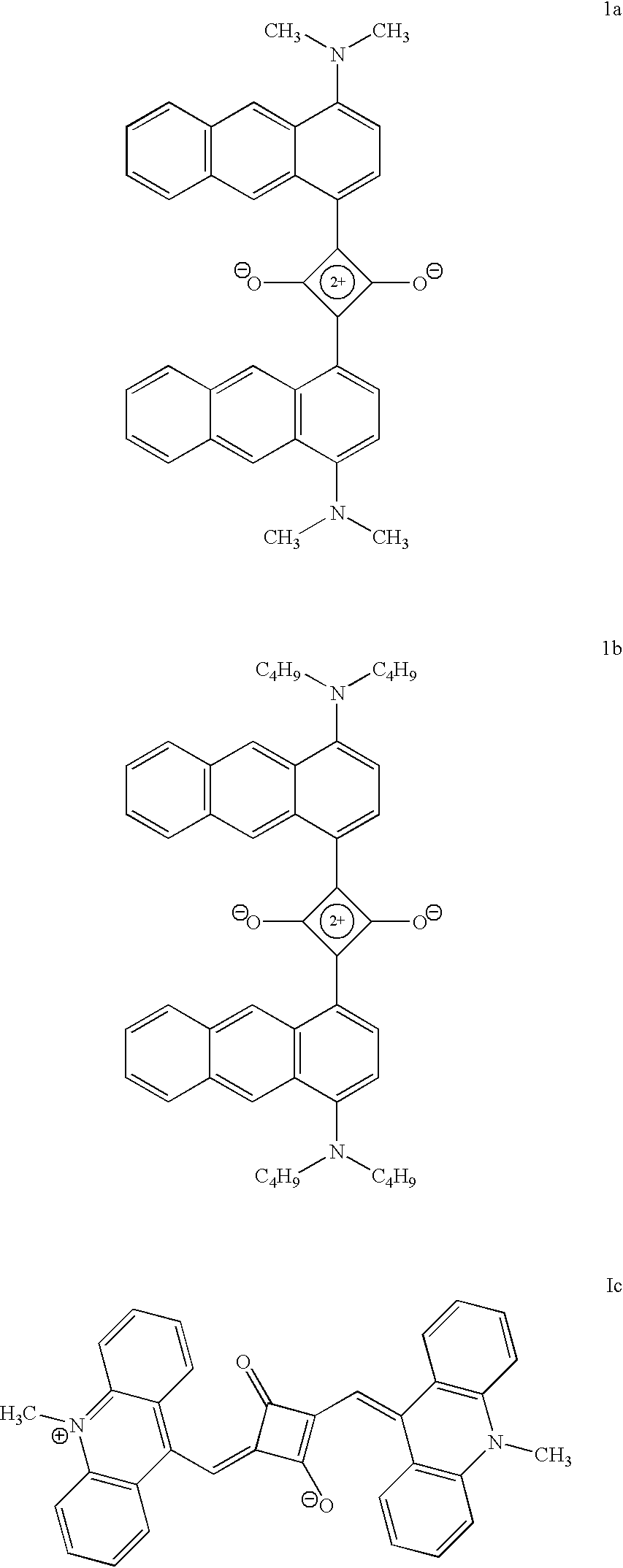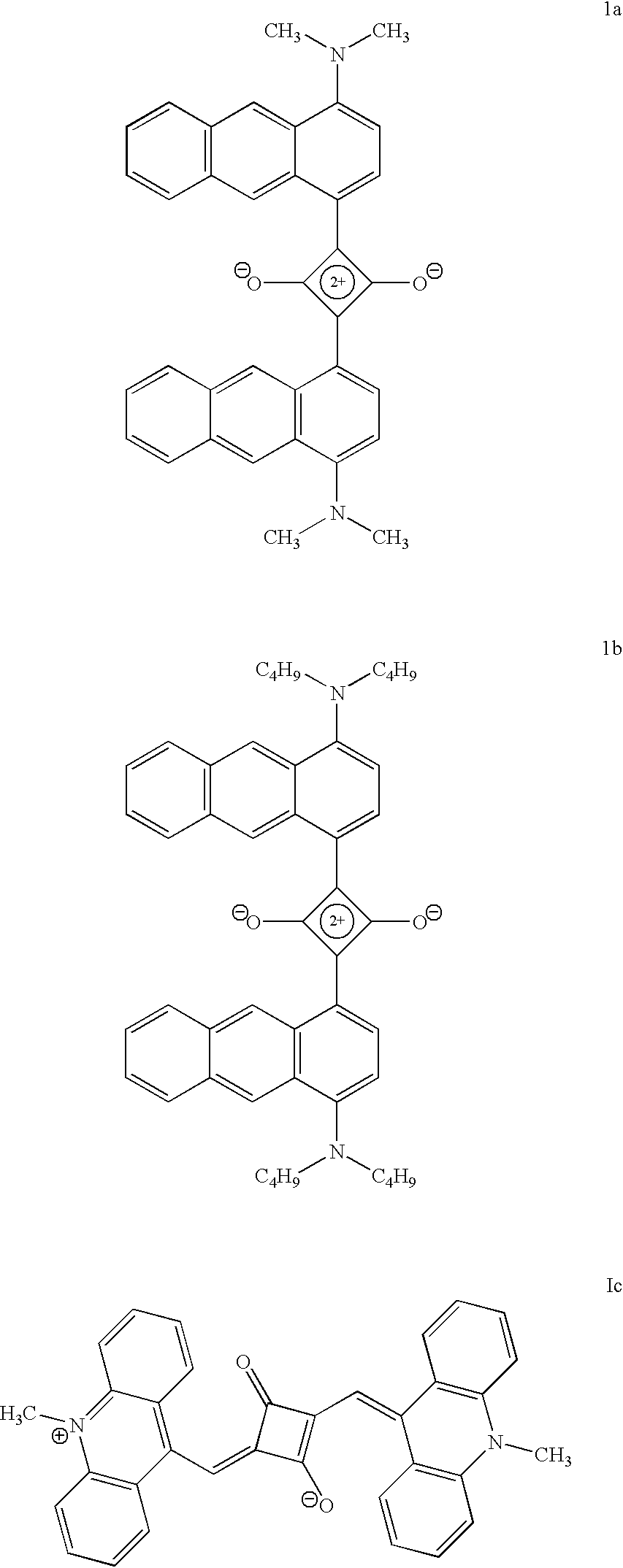Squaraine based dyes and process for preparation thereof
- Summary
- Abstract
- Description
- Claims
- Application Information
AI Technical Summary
Benefits of technology
Problems solved by technology
Method used
Image
Examples
example 2
Synthesis of formula 1b
A mixture of 1-N, N-dibutylaminoanthracene (500 mg, 1.63 mmol) and squaric acid (93 mg, 0.815 mmol) in n-butanol (15 mL) and benzene (6 mL) was refluxed for 12 h with simultaneous removal of water formed in the reaction. The reaction mixture was cooled, filtered and dried. The solid product obtained was recrystallized from a mixture of (1:4) chloroform and petroleum ether to give 63 mg (18%) of formula 1b which melted at 192.degree. C. IR (KBr) .nu..sub.max 1594 cm.sup.-1 NMR (CDCl.sub.3, 300 MHz) .delta. 1.9-0.7 (28H, m), 3.6 (8H, t) 7.07 (1H, d, aromatic C8 proton), 8.32 (1H, d, aromatic C5 proton), 8.59 (1proton), 9.51 (1H, d, aromatic C3 proton), 10.52 (1H, s, aromatic C10 proton); Mol. Wt. Calcd. For C.sub.48 H.sub.52 N.sub.2 O.sub.2 (MH+) 688.4029. Found (high-resolution mass spectrometry, FAB) 688.4003
example 3
Synthesis of formula 1c
A mixture of 6-methylacridinium iodide (3 mmol) and squaric acid (0.15 mmol) was heated at 120.degree. C. in a mixture (2.5) of 1-butanol and benzene for 12 h in the presence of pyridine. The water formed during the reaction was distilled off azeotiopically. After cooling, the reaction mixture was filtered and the residue was first purified by repeated washing with methanol. UV .lambda..sub.max (CH.sub.3 OH) 892 mm (41000 M.sup.-1 cm.sup.-1), Exact mass calculated 492.184; Found 492 IR .nu..sub.max (KBr) 2937, 1739, 1707, 1633, 1580, 1564, 1499, 1475, 1254, 1253, 1176, 1130, 1051, 756 cm.sub.-1, .sup.1 H NMR (CDCl.sub.3) .delta. 3.26 (s, N-CH.sub.3), 6.55-7.25 (m, aromatic).
example 4
There is considerable interest in the development of new near infrared absorbing dyes, especially in the 750-800 nm region for use with diode lasers. FIG. 1 shows the absorption spectrum of formula 1a in toluene and its absorption spectrum in the solid state is shown in FIG. 3. FIG. 2 shows the absorption spectrum of formula 1c in dichloromethane and its absorption spectrum in the solid state is shown in FIG. 4. In solution the compound formula 1a shows a sharp absorption band with absorption maximum around 780 nm and compound Formula 1c shows a sharp absorption band with maximum around 900 nm. In the solid state, both the compounds shows panchromatic absorption throughout the visible region and near-infrared legion (upto 1000 nm in the case of Formula 1a and upto 1700 nm in the case of formula 1c). The absorption maxima and extinction coefficients of the dyes in different solutions and also in the solid state are listed in Table 1. The close match of the absorption maxima of the dy...
PUM
| Property | Measurement | Unit |
|---|---|---|
| Fraction | aaaaa | aaaaa |
| Length | aaaaa | aaaaa |
| Length | aaaaa | aaaaa |
Abstract
Description
Claims
Application Information
 Login to View More
Login to View More - R&D
- Intellectual Property
- Life Sciences
- Materials
- Tech Scout
- Unparalleled Data Quality
- Higher Quality Content
- 60% Fewer Hallucinations
Browse by: Latest US Patents, China's latest patents, Technical Efficacy Thesaurus, Application Domain, Technology Topic, Popular Technical Reports.
© 2025 PatSnap. All rights reserved.Legal|Privacy policy|Modern Slavery Act Transparency Statement|Sitemap|About US| Contact US: help@patsnap.com



